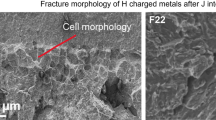Abstract
The aim of the work is to show the potentialities of the method of measuring ohmic resistance for investigating the anodic dissolution of metals. It is shown that simultaneous measurement of metal dissolution rate by using this method (by a change in the specimen weight, which is calculated by a change of its resistance) and by the charge consumed for the metal polarization enables us to determine the electrochemical equivalent of stainless steel. The dependence of cathodic component of the current on the anodic potential is obtained and the potential range adjacent to the open-circuit potential, where both anodic and cathodic reactions should be taken into account, is determined.






Similar content being viewed by others
REFERENCES
Analytical Methods in Corrosion Science and Engineering, Marcus, P. and Mansfeld, F., Eds., Boca Raton, FL: CRC Press, Taylor & Francis Group, 2006.
Mansfeld, F., The polarization resistance technique for measuring corrosion currents, in Advances in Corrosion Science and Technology, Fontana, G. and Staehle, R.W., Eds., New York: Plenum, 1976, vol. 6, ch. 2, p. 163.
Kelly, R.G., Scully, J.R., Shoesmith, D.W., and Buchheit, R.G., Electrochemical techniques, in Corrosion Science and Engineering, New York: Marcel Dekker, 2003.
Stansbury, E.E. and Buchanan, R.A., Fundamentals of the Electrochemical Corrosion, Materials Park, Ohio: ASM Int., 2000, ch. 6.
McCafferty, E., Introduction to Corrosion Science, New York: Springer, 2010.
Corrosion: Fundamentals, Testing, and Protection, Cramer, S.D. and Covino, B.S., Eds., ASM Int., ASM Handbook, vol. 13A, 2003.
Davydov, A.D., Kiriyak, E.N., and Kashcheev, V.D., Basic features of electrochemical alloy dissolution at high current densities. Nickel-chromium alloys, Soviet Electrochem., 1978, vol. 14, p. 352.
Davydov, A.D. and Volgin, V.M., Electrochemical machining, in Encyclopedia of Electrochemistry, Macdonald, D.D., Schmuki, P., Eds, Wiley, 2007, vol. 5, p. 809.
James, W.J., Anodic dissolution of metals – anomalous valence, in Advances in Corrosion Science and Technology, Fontana, M.G. and Staehle, R.W., Eds., New York: Plenum, 1974, p. 85.
Dražić, D.M. and Popić, J.P., Anomalous dissolution of metals and chemical corrosion, J. Serb. Chem. Soc., 2005, vol. 70, p. 489.
Suganya, S., Jeyalakshmim, R., and Rajamane, N.P., Corrosion rate monitoring of mild steel in underground soil at different depths using electrical resistance (ER) probe technique, Orient. J. Chem., 2017, vol. 3, p. 937.
Jankowski, J., Sokólski, W., and Hoffmann, A., Application of the electrical resistance technique to monitoring of cathodic protection effectiveness, Ochrona Przed Korozja, 2012, vol. 55, p. 347.
Cessna, J.C., Electrical resistance method for studying corrosion inhibitors in automotive anti-freezes, Corrosion, 1959, vol. 15, p. 67.
Azumi, K., Nakajima, M., Okamoto, K., and Seo, M., Dissolution of Ti wires in sulphuric acid and hydrochloric acid solutions, Corros. Sci., 2007, vol. 49, p. 469.
Hunt, G.J., Gahagan, M.P., and Peplow, M.A., Wire resistance method for measuring the corrosion of copper by lubricating fluids, Lubr. Sci., 2017, vol. 29, p. 279.
Roller, D. and Scott, W.R., Detecting and measuring corrosion using electrical resistance techniques, Corros. Technol., 1961, vol. 8, p. 71.
Corrosion Tests and Standards: Application and Interpretation, Baboian, R., Ed., Baltimore, MD: ASTM Int., 2005, p. 25.
Funding
The work was performed with support of Ministry of Science and Higher Education of Russian Federation.
Author information
Authors and Affiliations
Corresponding authors
Ethics declarations
The authors declare that they have no conflicts of interest.
Additional information
Translated by T. Kabanova
Rights and permissions
About this article
Cite this article
Rybalka, K.V., Beketaeva, L.A. & Davydov, A.D. Study of Anodic Dissolution of Stainless Steel in HCl by the Method of Measuring Ohmic Resistance. Russ J Electrochem 56, 239–242 (2020). https://doi.org/10.1134/S1023193520030106
Received:
Revised:
Accepted:
Published:
Issue Date:
DOI: https://doi.org/10.1134/S1023193520030106




